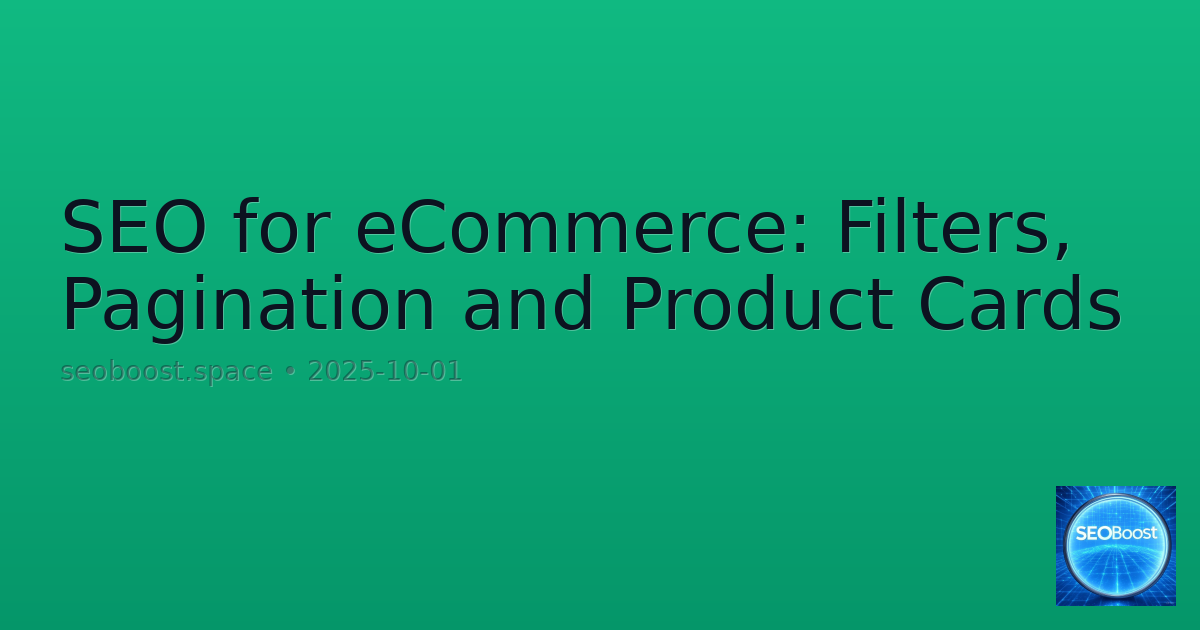SEO for eCommerce: Filters, Pagination and Product Cards
Опубликовано: 2025-10-01 21:00:36

As an eCommerce business owner, you know that search engine optimization (SEO) is essential to attracting organic traffic to your website. But how do you optimize your product pages for search engines? Here are 10 tips to improve your SEO through filters, pagination, and product cards.
Filters
1. Use descriptive labels: Use clear and descriptive labels for your filters, such as "size" or "color" instead of "attribute1" or "attribute2". This helps both users and search engines understand what each filter does.
Example: "Size" instead of "attr1"
2. Allow multiple selections: Let users select multiple filters at once to refine their search. This helps them find what they want faster and reduces bounce rate.
Example: "Select multiple sizes"
3. Use ranges: Allow users to filter by price, date, or rating ranges. This helps them find products within their budget or preference.
Example: "Price range: $10-$50"
4. Show filter counts: Show how many products match each selection to help users decide which filters to use.
Example: "Showing 10 products for 'red' and 'size M'"
5. Use canonical URLs: Prevent duplicate content by using a single URL for each filter combination.
Example: "yourstore.com/shoes?size=42&color=red"
6. Use filter history: Save users' last choices to speed up their future searches.
Example: "Remember my last filter choices"
7. Use AJAX: Load filters without page reloads for a smoother experience.
Example: "Filter without leaving the page"
8. Optimize filter pages: Use H1 and unique content for each filter combination.
Example: "Shoes for men's size 42 in red"
9. Use canonical tags: Prevent filter combinations from competing for rankings.
Example: "Canonical to main category"
10. Optimize for mobile: Make filters easy to use on small screens.
Example: "Collapsible menu"
Pagination
1. Use rel="next" and "prev": Help search engines crawl your pages.
Example: "Rel='next'"
2. Use infinite scroll: Load new products without page reloads.
Example: "Load more products"
3. Use canonical tags: Prevent duplicate content.
Example: "Canonical to first page"
4. Use "last" and "first": Show the last or first products.
Example: "Page 10" and "Page 1"
5. Use "next" and "prev": Help users navigate.
Example: "Page 3" and "Page 2"
Use "show" and "more": Show how many products are left.
Example: "Showing 1-12 of 100"
Use "next" and "prev": Show where you are.
Example: "Page 3 of 10"
Use breadcrumbs: Show users your location.
Example: "Shoes > Men's shoes > Size 42 > Red"
Product Cards
Use unique titles: Use unique titles for each product.
Example: "Red leather sneakers"
Use unique URLs: Use your product name.
Example: "yourstore.com/shoes-red-leather-sneakers"
Use descriptive URLs: Use hyphens, not underscores.
Use structured data: Add product details to search results.
Example: "Brand, price, rating"
Use high-quality images: Use clear and large images.
Example: "High-resolution images"
Use rich snippets: Add price, rating, and availability.
Example: "$30, 4.5 stars"
Use structured data: Add brand, SKU, and price.
Example: "Brand: Nike, SKU: 12345"
Use structured data: Add availability.
Example: "In stock"
Use structured data: Add reviews.
Example: "4.5 stars (10)"
Use structured data: Add reviews count.
Example: "10 reviews"
Conclusion
Improve your eCommerce SEO with these tips for filters, pagination, and product cards. Happy customers and search engines will follow.
Filters
1. Use descriptive labels: Use clear and descriptive labels for your filters, such as "size" or "color" instead of "attribute1" or "attribute2". This helps both users and search engines understand what each filter does.
Example: "Size" instead of "attr1"
2. Allow multiple selections: Let users select multiple filters at once to refine their search. This helps them find what they want faster and reduces bounce rate.
Example: "Select multiple sizes"
3. Use ranges: Allow users to filter by price, date, or rating ranges. This helps them find products within their budget or preference.
Example: "Price range: $10-$50"
4. Show filter counts: Show how many products match each selection to help users decide which filters to use.
Example: "Showing 10 products for 'red' and 'size M'"
5. Use canonical URLs: Prevent duplicate content by using a single URL for each filter combination.
Example: "yourstore.com/shoes?size=42&color=red"
6. Use filter history: Save users' last choices to speed up their future searches.
Example: "Remember my last filter choices"
7. Use AJAX: Load filters without page reloads for a smoother experience.
Example: "Filter without leaving the page"
8. Optimize filter pages: Use H1 and unique content for each filter combination.
Example: "Shoes for men's size 42 in red"
9. Use canonical tags: Prevent filter combinations from competing for rankings.
Example: "Canonical to main category"
10. Optimize for mobile: Make filters easy to use on small screens.
Example: "Collapsible menu"
Pagination
1. Use rel="next" and "prev": Help search engines crawl your pages.
Example: "Rel='next'"
2. Use infinite scroll: Load new products without page reloads.
Example: "Load more products"
3. Use canonical tags: Prevent duplicate content.
Example: "Canonical to first page"
4. Use "last" and "first": Show the last or first products.
Example: "Page 10" and "Page 1"
5. Use "next" and "prev": Help users navigate.
Example: "Page 3" and "Page 2"
Use "show" and "more": Show how many products are left.
Example: "Showing 1-12 of 100"
Use "next" and "prev": Show where you are.
Example: "Page 3 of 10"
Use breadcrumbs: Show users your location.
Example: "Shoes > Men's shoes > Size 42 > Red"
Product Cards
Use unique titles: Use unique titles for each product.
Example: "Red leather sneakers"
Use unique URLs: Use your product name.
Example: "yourstore.com/shoes-red-leather-sneakers"
Use descriptive URLs: Use hyphens, not underscores.
Use structured data: Add product details to search results.
Example: "Brand, price, rating"
Use high-quality images: Use clear and large images.
Example: "High-resolution images"
Use rich snippets: Add price, rating, and availability.
Example: "$30, 4.5 stars"
Use structured data: Add brand, SKU, and price.
Example: "Brand: Nike, SKU: 12345"
Use structured data: Add availability.
Example: "In stock"
Use structured data: Add reviews.
Example: "4.5 stars (10)"
Use structured data: Add reviews count.
Example: "10 reviews"
Conclusion
Improve your eCommerce SEO with these tips for filters, pagination, and product cards. Happy customers and search engines will follow.
Поделиться:
Telegram





